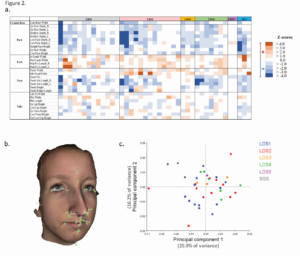Loeys-Dietz and Shprintzen-Goldberg syndromes are caused by mutations along the TGF-beta signaling pathway. Some of the most striking features include craniofacial anomalies. Yet it is very difficult to find a common facial pattern that can be matched to the specific mutation. We used deep clinical examination methods and cutting-edge imaging technology, such as 3D photos and 3D facial CTs, to examine how these mutations effect facial development. We found that mutations in the TGFBR2 and SKI genes caused the most severe facial changes due to changes of the cranial base that would explain the facial differences. Temporomandibular joint disorders and obstructive sleep apnea were more common than expected. These methods are extremely valuable in diagnosis and will help predict how genetic changes impact craniofacial development. (By Dr. Konstantinia Almpani, http://dx.doi.org/10.1136/jmedgenet-2021-107695).
Loeys-Dietz and Shprintzen-Goldberg Syndromes: analysis of TGF-β-opathies with craniofacial manifestations using an innovative multi-modality method
(Visited 308 times, 1 visits today)
